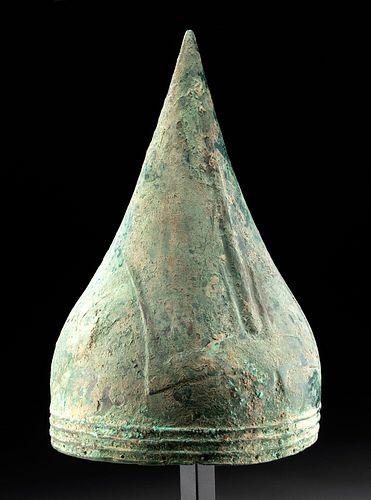Ancient Urartian Bronze Conical Helmet
Lot 65c
About Seller
Artemis Fine Arts
686 S Taylor Ave, Ste 106
Louisville, CO 80027
United States
Selling antiquities, ancient and ethnographic art online since 1993, Artemis Gallery specializes in Classical Antiquities (Egyptian, Greek, Roman, Near Eastern), Asian, Pre-Columbian, African / Tribal / Oceanographic art. Our extensive inventory includes pottery, stone, metal, wood, glass and textil...Read more
Categories
Estimate:
$20,000 - $30,000
Absentee vs Live bid
Two ways to bid:
- Leave a max absentee bid and the platform will bid on your behalf up to your maximum bid during the live auction.
- Bid live during the auction and your bids will be submitted real-time to the auctioneer.
Bid Increments
| Price | Bid Increment |
|---|---|
| $0 | $25 |
| $300 | $50 |
| $1,000 | $100 |
| $2,000 | $250 |
| $5,000 | $500 |
| $10,000 | $1,000 |
| $20,000 | $2,500 |
| $50,000 | $5,000 |
| $100,000 | $10,000 |
| $200,000 | $20,000 |
About Auction
By Artemis Fine Arts
Feb 13, 2020
Set Reminder
2020-02-13 10:00:00
2020-02-13 10:00:00
America/New_York
Bidsquare
Bidsquare : Exceptional Antiquities, Asian, Ethnographic
https://www.bidsquare.com/auctions/artemis-gallery/exceptional-antiquities-asian-ethnographic-4848
An important one-day auction featuring museum-worthy examples of Egyptian, Greek, Roman, Etruscan, Near Eastern, Far East / Asian, Pre-Columbian, African / Tribal, Oceanic, Native American, Spanish Colonial, Russian, Fossils, Ancient Jewelry, Fine Art, so much more! Artemis Fine Arts info@artemisfinearts.com
An important one-day auction featuring museum-worthy examples of Egyptian, Greek, Roman, Etruscan, Near Eastern, Far East / Asian, Pre-Columbian, African / Tribal, Oceanic, Native American, Spanish Colonial, Russian, Fossils, Ancient Jewelry, Fine Art, so much more! Artemis Fine Arts info@artemisfinearts.com
- Lot Description
Eastern Anatolia region of modern day Armenia, Turkey, Iran, Azerbaijan and Georgia, Urartu (Urartian or Urartian), Iron Age III, ca. 8th century BCE. A rare, beautifully preserved bronze helmet of an elegant conical shape formed from a hammered sheet of metal and tapering to a tall point. The front features a symmetrical lightning symbol in relief, extending up to the pointed tip along a tapering central rib. The lower edge features three horizontal encircling ridges with a row of tiny perforations along the edge for attachment of the lining and ear flaps. Size: 8" W x 11.7" H (20.3 cm x 29.7 cm); 20.95" H (53.2 cm) on included custom stand.
The civilization of Urartu (also known as the Kingdom of Ararat or the Kingdom of Van) was one of several states that arose following the destruction of the Hittite state in approximately 1200 BCE. Others included Tabal, Phrygia, and Lydia - each one possessed its own distinct language, religion, ethnicity, and visual culture. According to the Metropolitan Museum of Art Heilbrunn essay, "In their inscriptions, the Assyrians of Mesopotamia refer to the Urartians as their northern enemies from the eleventh to the seventh centuries B.C. However, the earliest known Urartian written document, a rock inscription at Van (ancient Tushpa), records the earliest reference to the state. There it says that Urartu was ruled by a king named Sarduri (r. ca. 840–830 B.C.), and mentions a male deity, Haldi, the supreme god throughout Urartian history."
Urartu had such skill with bronze work that the Assyrians would take their finished metal objects whenever they could, through trade, warfare, or plunder. For example, Assyrian king Sargon II listed 305,000 bronze daggers as the plunder from a successful campaign in Urartu. Their distinctive conical helmets often have fascinating iconographic work on their faces - like the lightning symbol here - with some even being so elaborate that they seem to have been made only for tombs or commemorating battles. This one, however, is nearly identical to one in the British Museum that features an inscription stating that it is from the arsenal of King Ishpuini (830-810 BCE) (collection #1968,1214.1).
See a very similar helmet that sold at Christie's, New York, on June 5, 2014, Lot 55, for USD $68,750.
Provenance: private New York, New York, USA collection; ex-Todd Figi collection, California, USA, acquired in the 2000s
All items legal to buy/sell under U.S. Statute covering cultural patrimony Code 2600, CHAPTER 14, and are guaranteed to be as described or your money back.
A Certificate of Authenticity will accompany all winning bids.
We ship worldwide and handle all shipping in-house for your convenience.
#153130Small area of repair/stabilization on one side of the brim, but otherwise in excellent condition. Great deep turquoise patina and deposits including some impressed textile that has been incorporated into the archaeological surface.Condition
- Shipping Info
-
All shipping is handled in-house for your convenience. Your invoice from Artemis Gallery will include shipping calculation instructions. If in doubt, please inquire BEFORE bidding for estimated shipping costs for individual items.
-
- Buyer's Premium



 EUR
EUR CAD
CAD AUD
AUD GBP
GBP MXN
MXN HKD
HKD CNY
CNY MYR
MYR SEK
SEK SGD
SGD CHF
CHF THB
THB















